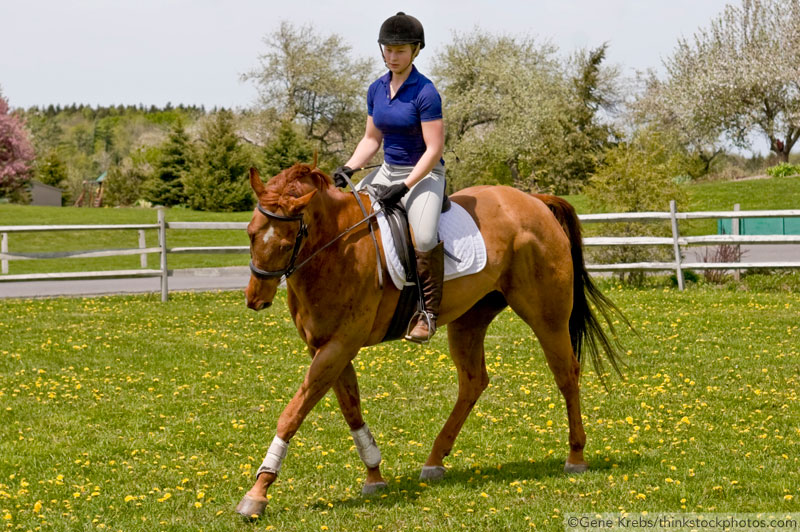
If you are riding at a lesson barn, look around for a bulletin board advertising used jodhpurs, breeches, gloves and boots. Another rider who has outgrown her clothes, upgraded, or switched disciplines may be selling her old riding apparel at a great price.
If you’re starting your riding wardrobe from scratch, it’s time to visit the local tack store. If you don’t have a tack store nearby, you may have to order riding gear from a catalog or an online shop. Your instructor or other riders at the barn may offer advice about which stores or catalogs to shop.
Here’s the basic gear you will need if you plan to ride regularly.
A Riding Helmet
A safety helmet is the most important item of riding gear. You should wear one every time you get on a horse. In fact, it’s not a bad idea to wear one while grooming or tacking up. Horses are unpredictable creatures and taking a simple, extra safety measure could save you from injury.
It’s best to visit a tack store so the helmet can be properly fitted by a tack store employee. Try on several brands to see which one fits the best. Some brands suit oval heads, while other brands are better for round heads.
Look for a helmet with a label in it that states it is ASTM/SEI approved. This means that it has met the tough standards of safety set by the American Society for Testing and Materials and the Safety Equipment Institute. The helmet should have a fixed leather or nylon chinstrap that cannot be removed.
Put on the helmet and adjust the strap under your chin. Move your head up and down and side to side. If the helmet moves or falls forward, it is too loose and you must look for a smaller size.
There are many types of helmets available. The most economical helmet will probably be a simple schooling helmet—these look like bicycle helmets. They are lightweight and have vents to keep your head cool. They come in all sorts of fun colors and styles and can even be dressed up with a velvet cover for shows. Velvet helmets are traditionally used in the hunter and jumper rings. Jockey skull caps are used by jockeys and eventers (people who jump over cross-country fences). Most riders opt to pair a skull cap with a hat cover with a flexible brim.
There are also western-style schooling helmets decorated in leather, and they come in natural colors like beige and brown. There are also western hats and derby-style hats with safety helmets hidden inside them, but they tend to be bulky and have not caught on with competitive western or saddle seat riders. However, riders in those disciplines may choose to wear regular helmets in competition without penalty.
Don’t try to save money by buying a used helmet. You may not be able to tell if it has been dented or damaged. And after a few years of use, the foam that lines many helmets becomes flattened and it won’t protect your child in a fall.
Footwear
Riding footwear should have low heels (½” to 1″) to help prevent your feet from slipping through the stirrup. Riding boots are designed to be safe and functional in the saddle. If you will be riding English, invest in a pair of paddock boots. Paddock boots are short, ankle-high boots made of leather or a synthetic material. If you ride western, look for a pair of well-fitting boots with a small heel and a semi-round toe.
If your area tends to get muddy in the winter and spring, you may want to spring for a pair of inexpensive, tall rubber riding boots. They look similar to the leather tall boots seen in the English show ring and you can rinse them off with a hose when they get dirty.
If you ride English and would like to compete, you will need to invest in a pair of tall boots. There are two main types of tall boot: dress boots, which are plain; and field boots, which have laces up the front. Dress boots are usually worn by riders who do dressage. Hunters and eventers tend to wear field boots.
Riding Pants
Jeans or long pants are acceptable for English riding lessons, but it’s a good idea to invest in a few pairs of breeches, jodhpurs or riding tights. Because they are stretchy, riding pants won’t rub your child’s legs like jeans will in an English saddle.
Jodhpurs are long riding pants that go down to the ankles and they are worn with paddock or jodhpur boots boots. Kentucky jodhpurs are worn by saddle seat riders and are usually made of polyester or a cotton/polyester blend. Breeches are shorter and fasten between the calf and ankle. They are worn with tall boots or half chaps and short boots.
Riding tights can be worn with tall or short boots. They are usually pull-on style, and they are very comfortable. They come in a wide variety of colors and in cooler fabrics for summer or insulated for winter. Bootcut tights are a newer option for the fashion-conscious and are generally worn over paddock boots.
If you think your child may show at some point, invest in a pair of plain beige jodhpurs or breeches so she can wear them when she competes.
If your child is going to ride western, jeans are the preferred riding attire. Just make sure they fit well so they don’t bunch up around the stirrup fender. Some riding jeans are made without inside leg seams, so you will be more comfortable in the saddle. Avoid low-rise jeans for riding, as you will often find that the rise gets even lower when mounting or sitting in the saddle.
Chaps
Chaps are leather leggings that are usually worn over jeans for casual riding. They fasten with side zippers. Western riders wear them in competition, but they aren’t allowed in an English show-ring. Chaps are great for winter riding because they help keep your legs warm. Some riders will zip up chaps over their shorts in the summer months.
Chaps can help prevent your legs from chafing, but they must fit snugly or they will rub the legs and cause painful sores. Buy them slightly tight because they will stretch a bit.
Half chaps are usually worn with breeches or jeans. They are made of suede, smooth leather or synthetic materials. They fasten over the lower leg with a zipper or hook and loop fastener. Many riders prefer them over tall boots for schooling because they are quick and easy to put on, and they help you to get a good grip on her horse’s sides.
Gloves
Whether your child rides English or western, investing in a pair of riding gloves is a smart idea. They protect hands from blisters and they give a firm grip on the reins. Leather gloves are nice for showing, but inexpensive cloth gloves with rubber grips will do the job for everyday riding. Insulated gloves are available for cold weather riding while crochet-back gloves are ideal for summer.
This article originally appeared in the 2008 edition of Horses USA






helpful!
goog info
Loved it!
Thanks!